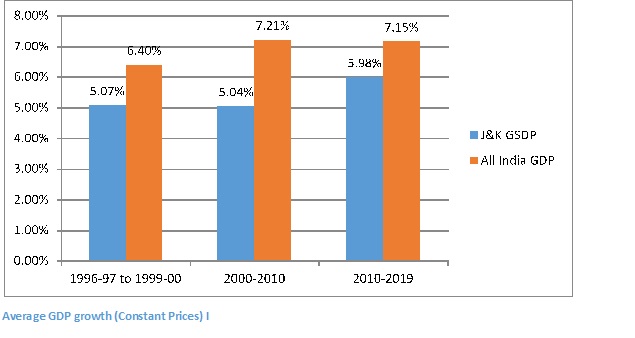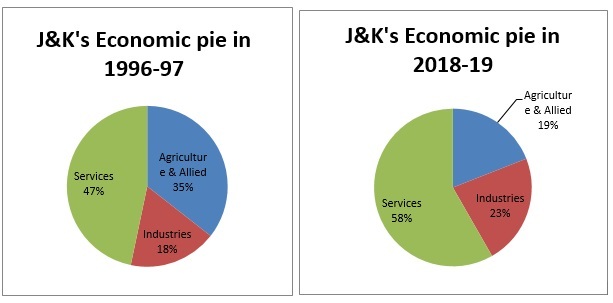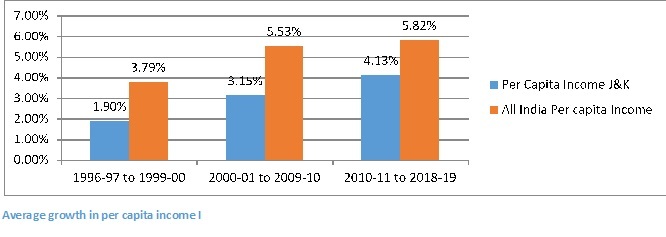
This is the first in a Four-part series that outlines the processes of change in J&K Economy since 1996-97
ITS year 2021 and we are at the cusp of an unfolding new decade. It also marks the 30th anniversary of the Indian economic liberalization. It was in the backdrop of economic crisis originating from dangerous levels of fiscal and current account deficit, depleting foreign exchange reserves, high inflation and a looming threat of sovereign debt default that India was compelled to take decisive reforms 30 years ago. In an epochal budget presented by the then Finance Minister Manmohan Singh, Government of India in 1991 took a tectonic shift in its national and international economic policy. It shunned away its post-independence Soviet Union influenced Fabian socialism and devalued its currency and integrated its businesses and supply chains with the global market-driven economic systems. Besides opening its gates to the world, the Government also reformed its domestic business environment by minimizing the hassle laden maze of bureaucratic red-tapism popularly known as the “license raj”.
Although critiques on the Left attribute the prevailing rising income inequality, ecological deterioration and unhealthy levels of consumption and personal debt to this laissez faire economic model, however, those on the other side are quick to flaunt the rising GDP numbers, reduction in poverty levels and other indicators of development as a counter argument. The fact remains that the momentous series of policy reforms in 1991 did alter the DNA of the Indian economy fundamentally. While numbers of the formal economy representing indicators of well being and economic progress did show remarkable growth when compared to pre 1991 parameters, however, when looked qualitatively, the distribution of this progress has been uneven and seemingly concentrated to urban centers and industrially advanced states. Amidst all the fireworks that were happening on the economic front at the national level, it will therefore be interesting to track as to how J&K’s economy fared in the last three decades of economic liberalization.
Economic trajectory in numbers:
1996-2020
While India was making structural changes in the economy, J&K in 1991 was grappling with one of the most ferocious armed rebellions in the recent history. With volatile political environment having engulfed the entire region and absence of any elected State Government, economy was paralyzed on all fronts in the 90’s.
In 1996, J&K witnessed the return of an elected Government after a gap of almost 7 years of presidential rule. Inheriting a miniscule GSDP of Rs. 6982 crore at constant prices (base year 1993-94) as on 1995-96, J&K’s new dispensation leveraging the low base effect registered an average growth of around 5.07 % to reach to a figure of Rs. 8509 Crore till FY 1999-2000. India on the other hand was growing much rapidly; registering an average growth of around 6.4% for the same period and over 6.6% for the 90’s decade.
The opening of the economy in 1991 didn’t start showing results immediately at the national level. Indian economy started accelerating a little later i.e. during the first decade of the 21st century at an average growth of 7.21 % with annual growth even crossing 9% for three consecutive years. Despite a thaw in the peace process between New Delhi and Islamabad during the first half of this decade, J&K’s average economic growth continued to lag behind at 5.04 % during the same period. In the last decade i.e. from 2010-11 to 2018-19 (data available till 2018-19) Indian GDP grew at an average of 7.15% compared to J&K’s GSDP of 5.98%. This spike in J&K’s GSDP can be attributed to the outlier growth rate of 18.23% registered in FY 2015-16. Besides the low base of the preceding year, reason for this spike is based on the colossal loss of property and factors of the economy during the great floods of 2014. As a result, 2015-16 witnessed a major spur in rebuilding. The land, labor, capital and enterprise that were used to rebuild the broken infrastructure added to the production of that year thereby causing a spur in the GSDP numbers.

The long picture for these 24 years i.e. the all India GDP growth from FY 1996-97 till FY 2018-29 averaged at around 6.90 %. The average GSDP growth rate, on the other hand, at which the economy of J&K’s progressed for the same period arrives at 5.41% i.e. about 149 basis points less than the national average. Theoretically, at this rate India is doubling its economic size every 10.43 years compared to J&K which takes over 13.30 years to achieve a similar feat. It is pertinent to mention that these GDP numbers are at constant prices with periodic base year changes i.e. real values discounted for inflation. This huge gap of almost 3 years is creating a wide economic gulf after every cycle. This lag clearly indicates that the fruits of liberalization were uneven in distribution and economies like J&K are emerging as laggards in the long run.
Impact on the composition of J&K economy:

The composition of J&K economy has undergone a sizeable transformation since 1996-97. The all India level share of primary sector at 19.90% is almost at the same level with that of J&K at 19%. Contribution of Industries sector at 25.33 % at all India level is well ahead of J&K’s 23%. The services sector at national level slices 54.77% share in the pie compared to J&K’s 58%. J&K’s service sector has outpaced the other two sectors by a fair margin. From 47% contribution to a whopping 58%, services are emerging as the main driver of the regional economy. Primary sector comprising of agriculture and allied activities is shrinking fast in terms of its impact on the economic output. Industries sector on the other hand has moved at a snail’s pace. Although shrinking role of agricultural sector is considered as a healthy sign for advancing economies, however, the lack of growth in industrial sector depicts an unhealthy drag in terms of capacity development, employment creation and widening of tax base.
Per Capita Income:
The gulf created by the lagging economic acceleration and industrial development since 1996 can easily be gauged by tracking the movement of J&K’s per capita income in comparison to all India levels. J&K’s per capita income in real terms (adjusted for inflation) in FY 1996-97 was Rs. 6978, whereas the All India average for the same period stood at Rs. Rs.9007 i.e. approximately 29% higher. Today, the chasm between the incomes is much wider with All India per capita income over 34% higher than that of J&K. The decadal growth patterns in J&K when pitched against all India levels depict a gradual lag in J&K’s per capita incomes. From 1996-97, J&K’s per capita income grew at a dismal growth of 1.90%, then from 2000-01 to 2009-10 it grew at an average rate of 3.15% and from 2010-11 to 2018-19 it registered an average growth of 4.13%. The all India average for the same period clocked at 3.70%, 5.53% and 5.82% respectively.

Measuring from a wider time frame i.e. from 1996 till 2019, J&K’s per capita income has grown at an average of around 3.38% compared to an impressive all India average of 5.41%. Which implies that in real terms (adjusted for inflation), nationally the income is doubled every 13.30 years, while in case of J&K it takes around 21.30 years for the same. This gives a fair idea about the velocity with which the distance between J&K’s people and average Indian is widening in income terms. Although the income distribution at national level is much concentrated leading to higher inequalities, however, per capita as an indicator does show the limited role that liberalization has done in uplifting the economies of regions like Jammu and Kashmir when compared to aggregate values.
A look at the trend of macroeconomic variables of J&K since 1996 is projecting a clear pattern. Firstly, the speed of growth in J&K in all the three periods of observation is lagging behind all India averages by a fair margin resulting in economic backwardness, poor capacity to soak employment pressure and limited appetite to create investment and business opportunities. Secondly, the industries sector is creating a drag on the region’s ability to accelerate economic output, develop indigenous capacities of manufacturing and construction and widen the regional Government’s tax base. Thirdly, this poor performance is resulting in widening of gap between average incomes. The pace of income growth has been quite dismal in case of J&K when compared to national averages resulting in smaller savings, dwarfed investments and restricted consumption.
It is matter of fact that the region of Jammu and Kashmir has been marred with sustained political uncertainties, treacherous road connectivity, and hostile climate, paucity of skilled workforce, power shortages and unreliable communication networks. Despite these chronic impediments, the regional economy seems to have done reasonably well in surviving the odds with tremendous grit. Expecting investment from the private sector is nothing short of a fantasy when even Government of India, which had no restrictions on account of Article 370 or 35A, couldn’t invest in J&K all these years. Pertinently, GOI has an investment of about Rs. 25 Lakh crore through its hundreds of central PSUs across India. However, as on date, it could trust J&K with a paltry sum of only Rs. 150 crore. When the spender of the last resort is shying away from investing in J&K with such a miserly approach, one can very well imagine the apprehensions of private players. Nevertheless, one can only hope that factors marring the investment and business environment get addressed and instead of focusing too much on external inflows, domestic businesses take the plunge and create capacities to improve self-sufficiency and economic dignity.
*Data has been taken from Reserve Bank of India website, various economic surveys and state budgets
Views expressed in this article are author’s own and do not necessarily represent the editorial stance of Kashmir Observer
Follow this link to join our WhatsApp group: Join Now
Be Part of Quality Journalism |
Quality journalism takes a lot of time, money and hard work to produce and despite all the hardships we still do it. Our reporters and editors are working overtime in Kashmir and beyond to cover what you care about, break big stories, and expose injustices that can change lives. Today more people are reading Kashmir Observer than ever, but only a handful are paying while advertising revenues are falling fast. |
| ACT NOW |
| MONTHLY | Rs 100 | |
| YEARLY | Rs 1000 | |
| LIFETIME | Rs 10000 | |










